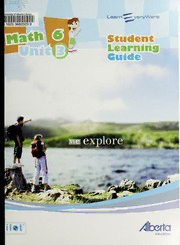
Preview Math 6
.20x2. '22- V. n Learn venyWane 1620 3682023 9 student Learning Guide /dlbcrfa Education Digitized by the Internet Archive in 2017 with funding from University of Alberta Libraries https://archive.org/details/math603gain Math 6 Learn EveryWare - Unit 3 Student Learning Guide ISBN: 978-0-7741-3105-6 Copyright © 2009, Alberta Education. This resource is owned by the Crown in Right of Alberta, as represented by the Minister of Education, Alberta Education, 10155 - 102 Street, Edmonton, Alberta, Canada T5J 4L5. All rights reserved. No part of this courseware may be reproduced in any form, including photocopying (unless otherwise indicated), without the written permission of Alberta Education. This courseware was developed by or for Alberta Education. Third-party content has been identified by a © symbol and/or a credit to the source. Every effort has been made to acknowledge the original source and to comply with Canadian copyright law. If cases are identified where this effort has been unsuccessful, please notify Alberta Education so corrective action can be taken. THIS COURSEWARE IS NOT SUBJECT TO THE TERMS OF A L ICENCE FROM A C OLLECTIVE OR LICENSING BODY, SUCH AS ACCESS COPYRIGHT. Math 6 Learn EveryWare has been developed under the terms of an agreement with Etraffic Press® and Alberta Education - Distributed Learning Resources Branch. Nath O Creator Publisher K - 12 Wayne Poncia Dr. Barry Carbol Author Publisher Professional Development Michelle Gainer Dr. Elizabeth Childs Contributing Authors Math Editors Harvey Knapp Grant Mellemstrand Lisa Read Wayne Loutet Nancy Claire Duchaine Pat Giommi Project Coordinator Julia Schenck Senior Editor Dr. Mary Ellen Bafumo Product Coordinator Robert Bailey Editor Mary Dillon Production Designers Antonio Escude Production Manager Francisco Cumayas Sandi van Katwijk Liviu Peicu Sherif Sidky Print Design Coordinator Carrie Todd Flash Developers Harry Kim Animators Ryan Thomson Rob Jones Stephen McCallum Illustrators Antonio Escude Multimedia Designer Carrie Todd Tyler Pantella Francisco Cumayas Ingrid Mesquita Senior Developer Liviu Peicu Leo Shen Sherif Sidky Etraffic Press® would like to acknowledge the production and project teams of Etraffic Solutions^*^ Inc. and The Distributed Learning Resources Branch for theircontributions to the project management, design, editing and development of this publication. Table of Contents Lesson I: Identifying Angles I Lesson t: Measuring and Creating Angles 9 Lesson 3: Polygons I 7 Lesson 4: Classifying Triangles tS Lesson 5: Interior Angles of Polygons 3 3 Lesson 6: Congruent Polygons 4 1 Lesson 7: Transformations on a Coordinate Plane 47 Lesson 8: Measuring and Describing Transformations 59 Lesson 9: Combining Transformations 7 1 Lesson lO: Transformational Designs 8 1 Lesson II: Perimeter of Polygons 87 Lesson II: Area of Rectangles 95 Lesson 13: Volume »••••».». 103 Sources * Ill Math • Lesson I Identifying Angles Parliament Hill The federal Canadian parliament buildings are located in Ottawa, Ontario. This is the capital of Canada. The Centre block, West block and East block buildings were built between 1859 and 1866. The Centre block is the site of the Peace Tower. The Peace Tower was completed in 1927. The Peace Tower stands at over 92 metres in height. There are many angles that were used along the roof lines of the Parliament buildings. These angles have names that are based on the measure of the angles. ■"i!rT.nx ml d Illi. h¥: im. tAiAiA. II ti liAy l y Al I1▲l1 l UI▲l Il lIAi Il l I▲l I IA I AI mmHAi I A lliAi i yi Aam i iM iAii iu aAu i_ 1A 1 i Ail l il^bU! yiii Hath O 3-1 Lesson I: Identifying Angles Objectives for this Lesson In this lesson you will explore the following: • Estimate the measure of an angle • Sketch angles • Provide examples of angles found in the environment • Classify a given set of angles Angles In the study of Geometry, there are figures with specific names. One of these figures is an angle. Angles have two sides. The sides can be rays or line segments. The angle is formed by combining two rays or line segments at a common endpoint called the vertex. A ray is part of a line that starts at an endpoint and extends in one direction without end. Ray • ► An angle is two rays with a common vertex: Angle Angles are measured using a unit of measure called degrees. One degree is of a circle. 3-2 Lesson I: Identifying Angles There are special angles that you should be able to determine the measure of at a glance. 90° Angle You may recall that this is a right angle from studying two-dimensional shapes such as rectangles and squares. You should also recall that the box in the corner is used to show that an angle is a right angle. 180° Angle , o , This angle is also called a straight angle. Reflection Why do you think the 180° angle is called a "straight angle"? Math O 3-3 Lesson I: Identifying Angles • Go online to watch the Notepad Tutor Lesson: 45°, 90°, and 180° Angles. 45® Angle 135® Angle You can use these angles to estimate the measure of other angles. Example 1 Estimate the measure of the angle given: Use an angle that you know to compare: 45° Here is a 45° angle on top of the angle. You can see that the angle we need to estimate is a little less than half the size of the 45° angle. An estimate of the angle is: 20° 3-4
